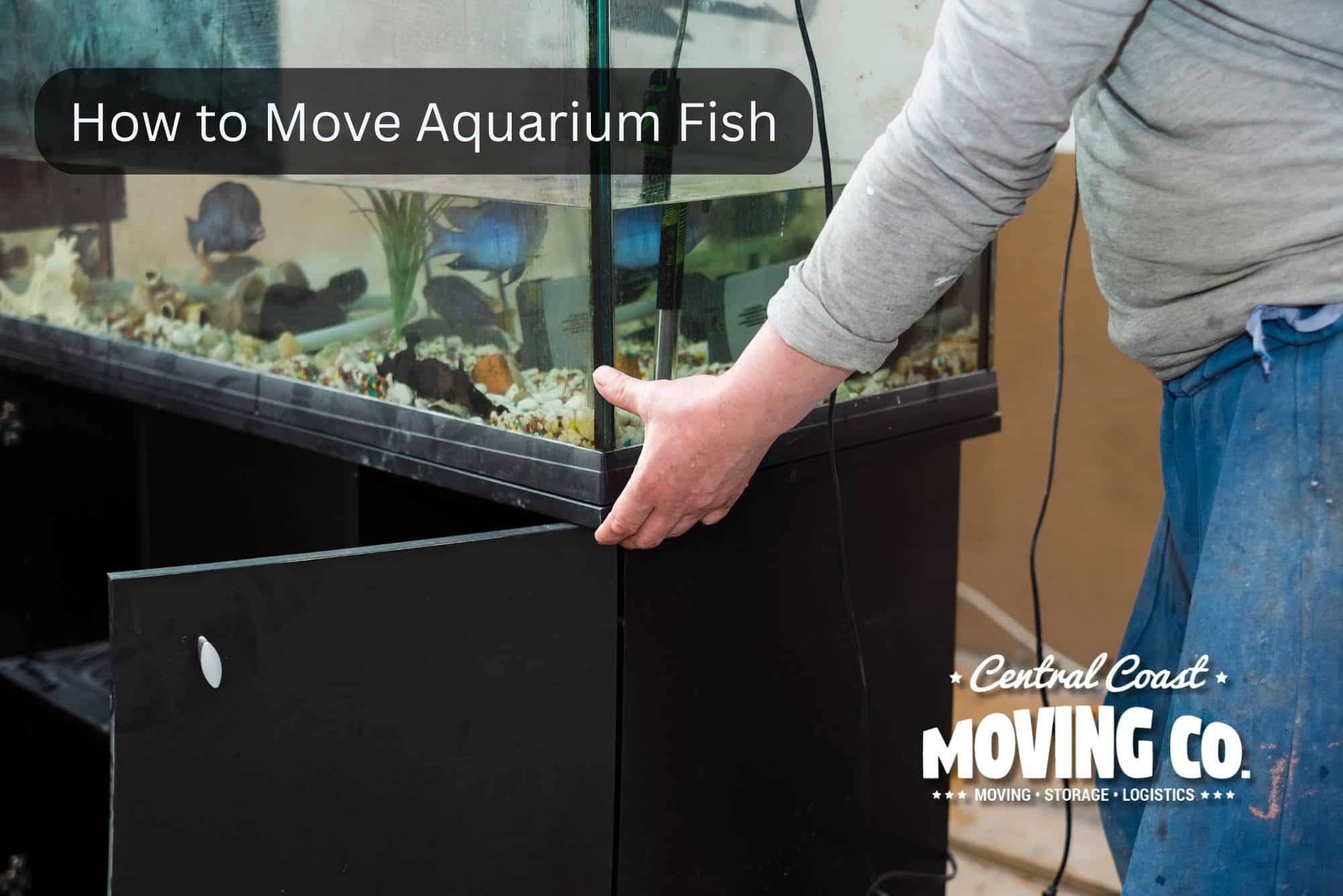Moving with cats can be challenging, even more so than moving with other pets. Cats, known for their strong territorial instincts and attachment to routines, can become stressed or anxious when faced with significant changes. As every cat owner knows, these beloved creatures thrive on stability, familiar environments, and predictable daily activities. This makes moving to a new home a potentially daunting experience for both you and your feline companion. It’s essential to treat your feline friend with gentle handling and maintain their routine as much as possible during the move to help minimize stress.
At Central Coast Moving, we understand that the well-being of your pet is just as important as transporting your belongings safely. Whether you’re relocating within the heart of Santa Barbara, settling near the beaches of Pismo Beach, or heading inland to Paso Robles, our mission is to ensure your move is smooth, stress-free, and comfortable for your entire family, including your furry friends. When moving house with a cat, careful preparation, maintaining routines, and allowing for gradual adjustment are key to supporting your pet’s well-being throughout the transition.
This comprehensive guide offers practical, expert-backed advice on moving with cats, from essential pre-move preparations to settling comfortably into your new home. Packed with valuable insights, our aim is simple: to empower you with the knowledge you need to reduce anxiety, ease your cat’s transition, and achieve a harmonious move.
Why Cats Find Moves Stressful
Cats are famously independent yet paradoxically sensitive creatures, deeply attached to their territories and routines. Unlike humans, who may view moving as exciting or at least manageable, cats interpret the event entirely differently. They associate safety, security, and comfort with familiar smells, spaces, and consistent routines. A sudden influx of packing boxes, unfamiliar noises, rearranged furniture, and disruptions to feeding schedules can trigger intense anxiety in your cat. Moving is one of the most common stressful events for cats, often causing significant distress.
Stress manifests in various ways, and it’s vital to recognize these behaviors early. Your normally playful and outgoing cat may begin hiding for extended periods, refuse food, show aggression, vocalize loudly, or start marking territory outside their litter box. These actions are your cat’s way of communicating discomfort, confusion, or fear about the changes happening around them. For many cats, a move is a stressful experience that can lead to emotional and behavioral challenges.
Cats can even sense disruption before it fully occurs. Many cat owners observe their feline companions becoming unusually clingy or restless as packing activities increase. Cats are perceptive enough to pick up on subtle shifts in their owners’ behavior or emotional state, heightening their anxiety well before moving day itself. During this time, cats can feel overwhelmed by the changes in their environment and routine.
Reducing stress during your move involves careful preparation, maintaining your cat’s familiar routines and belongings, gradual exposure to packing and moving supplies, and ensuring a calm environment. As you plan your relocation, whether you’re moving to downtown San Luis Obispo or settling into a seaside community near Morro Bay, recognizing and proactively managing your cat’s stress is the key to a successful, peaceful transition.
Pre-Move Preparation
The key to a successful move with your cat starts well before moving day. Preparation is essential—not just for packing up boxes or hiring movers, but for helping your cat feel safe, secure, and gradually acclimated to change. By thoughtfully preparing weeks in advance, you can ease the transition and minimize the risk of stress-related behavior. Crate training your cat ahead of time can help them become comfortable with the carrier, making the move less stressful.
Visit the Veterinarian
Before your move, schedule a routine check-up with your vet. This is a good opportunity to make sure your cat is healthy, up to date on vaccinations, and microchipped with accurate contact information.
If your cat has a history of anxiety or struggles with travel, your vet may recommend pheromone sprays, calming supplements, or, in some cases, short-term anti-anxiety medication for the journey. Pheromone diffusers are another option your vet might suggest to promote relaxation and help your cat adjust to new environments.
Pheromone spray can be applied to your cat’s bedding, carrier, or blankets to help them feel more secure during stressful situations.
Prepare the Carrier Early
Most cats associate their carriers with negative experiences, like vet visits or loud car rides. That’s why it’s important to start desensitizing your cat to the carrier as early as possible. Place it in a quiet, accessible area of the home and line it with your cat’s favorite blanket or soft bedding.
Leave the carrier open so your cat can explore and acclimate to it at their own pace. Encourage your cat to explore it voluntarily by placing treats, toys, or small meals inside. The goal is to help your cat see the carrier as a familiar and comfortable space, not something to fear.
Over time, close the door briefly while your cat is inside to get them used to the sensation. You might also try taking them on short car rides in the carrier to help build tolerance to movement and unfamiliar sounds.
Introduce Packing Gradually
Cats can be easily overwhelmed by environmental changes, so try to introduce packing materials and moving boxes gradually rather than all at once. Start by placing empty boxes in corners of rooms your cat already enjoys. Let them sniff, rub, or even nap in them. This small step can help your cat feel like they’re still in control of their territory as things begin to shift.
When packing begins in earnest, try to do so room by room and keep one area of the home unchanged for as long as possible. This “comfort zone” gives your cat a retreat when the rest of the house starts to feel chaotic.
Maintain Routines
Consistency is comforting for cats. Continue feeding, playtime, and bedtime routines at their usual times, even as you prep for your move. Avoid loud music or erratic schedules when possible. Familiar scents and rhythms signal to your cat that their world isn’t spinning out of control, even when boxes are piling up around them.
By planning ahead and making small adjustments in the weeks before your move, you can set the stage for a much smoother transition when the big day arrives.
Moving Day Tips

When moving day finally arrives, tension tends to run high. Loud noises, unfamiliar faces, and open doors can create a chaotic atmosphere that leaves your cat feeling anxious or unsafe.
With a little forethought and a few proactive steps, you can keep the day as calm and predictable as possible for your feline companion. Preparing for the actual move by planning strategies to reduce stress during this critical period will help ensure your cat’s well-being throughout the transition.
Create a Safe Room
Before the movers arrive, set up a quiet, secure space where your cat can stay safely out of the way. Choose a low-traffic room with a door that closes fully, preferably one that won’t be accessed during the move. Place your cat’s litter box, food and water bowls, favorite bed or blanket, and some familiar toys in the room.
Bring the carrier into this space early, so your cat can retreat into it if they choose. Close the blinds or curtains to reduce visual stress, and consider playing soft music or white noise to muffle outside sounds. Post a sign on the door that clearly states “Do Not Open – Cat Inside” to prevent any accidental escapes.
Stick to Routine (as Much as Possible)
Even on moving day, try to maintain your cat’s regular schedule. Feed them at the usual time and spend a few quiet minutes with them before the heavy lifting begins. A brief play session or cuddle can help reduce anxiety and remind your cat that they’re still your top priority, even in the midst of the move.
Time Meals Strategically
To prevent nausea or discomfort during travel, consider feeding your cat a slightly smaller meal a few hours before leaving. An overly full stomach can contribute to motion sickness in the car. Be sure to offer water, but avoid treats or new foods on moving day, stick to what they know.
Travel Safely
When it’s time to load up, gently place your cat in their carrier and secure it in the vehicle. The safest place is on the floor of the back seat or belted in securely, never in the trunk or an unsecured seat. Drape a light towel or blanket over part of the carrier to reduce visual stimulation, but make sure there’s plenty of ventilation.
Speak calmly to your cat during the ride, but avoid opening the carrier unless absolutely necessary. Most cats prefer quiet and minimal interaction while in transit. If your journey is long, plan to stop for water breaks, but do not let your cat out of the carrier until you are in a secure, enclosed space.
By planning ahead and creating a safe, calm environment, you can help your cat make it through moving day with minimal stress. This sets the stage for a smoother adjustment in their new home.
Avoiding Common Mistakes
When moving to a new house with your cat, it’s easy to overlook small details that can make a big difference in your feline friend’s comfort and safety.
One of the most common mistakes is allowing your cat to roam freely during the moving process. Even if your cat is usually confident, the chaos of moving to a new environment can leave them feeling overwhelmed and vulnerable.
To keep your cat safe, always keep your cat indoors throughout the move. Use a secure cat carrier or set up a single room with familiar objects, like their favorite blanket, litter tray, food, and water bowls, so your cat can feel secure amidst the changes.
Another frequent misstep is introducing your cat to the entire house all at once. While it’s tempting to let your cat explore their new home immediately, most cats adjust best when they can explore at their own pace. Start by confining your cat to one room, filled with familiar scents and comforts, and slowly introduce them to other rooms over time. This gradual approach helps your cat build confidence and reduces the risk of stress or escape.
It’s also crucial to keep all doors and windows closed, especially during the hustle and bustle of moving day. Open doors and windows can be an invitation for a frightened cat to bolt into unfamiliar territory, making it much harder to keep your cat safe. Double-check that windows are secure and that everyone involved in the move knows which room your cat is in.
By avoiding these common mistakes (keeping your cat indoors, using a cat carrier or single room, introducing new spaces slowly, and ensuring doors and windows are closed) you’ll help your cat feel secure and supported as they adjust to their new house. Taking these precautions will make the transition smoother for both you and your feline companion, setting the stage for a happy, stress-free start in your new home.
Arrival & Settling In
Once you arrive at your new home, your cat’s transition is far from over. Cats need time, consistency, and reassurance to feel secure in unfamiliar surroundings. Helping your cat adjust to their new surroundings requires patience and a gradual introduction to the space. The first few days are critical in helping them build confidence and comfort in their new environment.
Start with a Safe Room
Before opening the carrier, prepare a quiet, enclosed room where your cat can stay for the first several days. This space should contain everything they need: food and water bowls, a litter box placed away from feeding areas, a cozy bed, scratching post, and a few familiar toys. Add a piece of your unwashed clothing or a blanket from the old home to offer reassuring scents.
When you first let your cat out of the carrier, allow them to explore at their own pace. Some cats may immediately begin sniffing and exploring, while others may hide behind furniture or retreat to the carrier. Resist the urge to coax or force interaction. What they need most right now is control over their environment.
Spend time quietly sitting in the room with your cat, offering treats or gentle verbal reassurance. You can also place treats around the room or inside the carrier to encourage positive associations and gentle exploration. Avoid sudden movements, loud noises, or frequent visitors during this initial stage. This is your cat’s time to orient themselves and establish a sense of safety.
Expand Their Territory Gradually
After a few days—once your cat is eating, using the litter box regularly, and showing signs of relaxation—you can begin expanding their access to the rest of the home. Leave the safe room door open and let your cat explore on their own terms. Always allow them to retreat to their safe space as needed.
Keep in mind that cats often explore new territory in stages. They may venture into one room and then scurry back. This back-and-forth behavior is completely normal and signals that your cat is testing boundaries while keeping a safety net in place.
Avoid moving furniture around too much during this phase, and try to maintain consistency in where food, water, and litter boxes are located. If possible, set up items in a layout similar to your previous home. Familiar patterns help your cat feel grounded in a new space.
Keep Them Indoors for Now
Even if your cat is used to going outside, keep them strictly indoors for at least two to four weeks. This is especially important if your cat is an outdoor cat, as they may be more likely to get lost or disoriented in a new environment. During this time, they’re learning to recognize their new home as safe territory. Letting them out too soon can result in confusion, stress, or attempts to return to their previous location.
Once your cat seems comfortable indoors and has fully adjusted to the home, you can begin to introduce limited, supervised outdoor time, if that’s part of your routine. Start with short sessions in a secure yard or on a leash and harness. Always make sure they have access back into the home and never force them outside.
Watch for Signs of Stress or Discomfort
Even with the best preparation, some cats may struggle with the transition. Keep an eye out for red flags like refusal to eat, consistent hiding, vocal distress, litter box avoidance, or aggression. While some stress is expected, behaviors that persist beyond a week or worsen over time may require a call to your veterinarian.
With time, patience, and steady routines, most cats will adjust beautifully to their new home. Your calm presence, familiar items, and attention to their emotional cues will make all the difference in helping them feel safe and secure.
Final Considerations
As you settle into your new house, a few final steps can make all the difference in helping your cat adjust and thrive. First, don’t forget to update your cat’s microchip information with your new address. This simple step is essential for your cat’s safety, especially in a new environment where they may be tempted to explore.
To help your cat feel secure, surround them with familiar objects from your old home—scratching posts, favorite toys, and their usual litter box. These items carry comforting scents and memories, making the new house feel more like home. Consider using calming products such as pheromone sprays or diffusers to encourage positive associations and reduce stress during the adjustment period.
Establishing a consistent routine is also key. Feed your cat at the same times each day, set aside moments for play and affection, and keep up with regular veterinary check-ups. This predictability reassures your cat and helps them settle into their new environment with confidence.
If you notice any signs of ongoing stress—such as changes in appetite, hiding, or litter box issues—don’t hesitate to seek veterinary advice. With patience, love, and attention to your cat’s needs, most cats will adapt beautifully to their new home. By prioritizing your feline friend’s comfort and well-being, you’ll ensure a stress-free transition and a happy start to life together in your new house.
Where We Work: Pet‑Friendly Moving Services on the Central Coast
At Central Coast Moving, we know that every move is personal, especially when it involves pets. That’s why we don’t just move boxes; we move lives, memories, and families. Whether your journey is across town or across counties, our experienced team is here to ensure that even your most sensitive travelers, like your cat, are cared for with professionalism and empathy.
We proudly serve communities throughout California’s Central Coast, offering expert relocation services to homeowners and renters in a variety of settings. From cozy bungalows to multi-level homes, we understand the logistical and emotional nuances of moving with pets.
Are you settling into a new home in San Luis Obispo or planning a long-distance move from Santa Maria? Our team has handled hundreds of pet-inclusive moves throughout the region. We’re also familiar with the quieter residential areas of Paso Robles, where outdoor cats may need a more gradual reintroduction to unfamiliar territory. If you’re moving into a seaside property near Pismo Beach, we can help you plan ahead for managing doors, decks, and outdoor spaces that might otherwise pose challenges for your cat.
Make Your Next Move Stress-Free with Central Coast Moving

Moving with cats requires more than just planning and packing—it calls for empathy, patience, and a deep understanding of how cats experience change. From preparing your cat weeks in advance to setting up a safe room, managing transport, and easing them into their new environment, each step plays a role in building a smoother, less stressful transition.
With the right approach, your cat can settle comfortably and confidently into your new home. And you don’t have to do it alone.
At Central Coast Moving, we treat every move like it matters. We understand how important your pets are to your family, and we’re committed to offering the care, attention, and flexibility that moving with pets demands. Whether you’re moving for the first time or you’re a seasoned mover with multiple pets, our team brings the experience and compassion to make it easier on everyone, including your four-legged friends.
Let us help you take the stress out of moving, so you can focus on what matters most: creating a new home where you and your cat can thrive together.
Contact Central Coast Moving today to learn more about our pet-friendly moving services or to schedule a consultation with our team!







